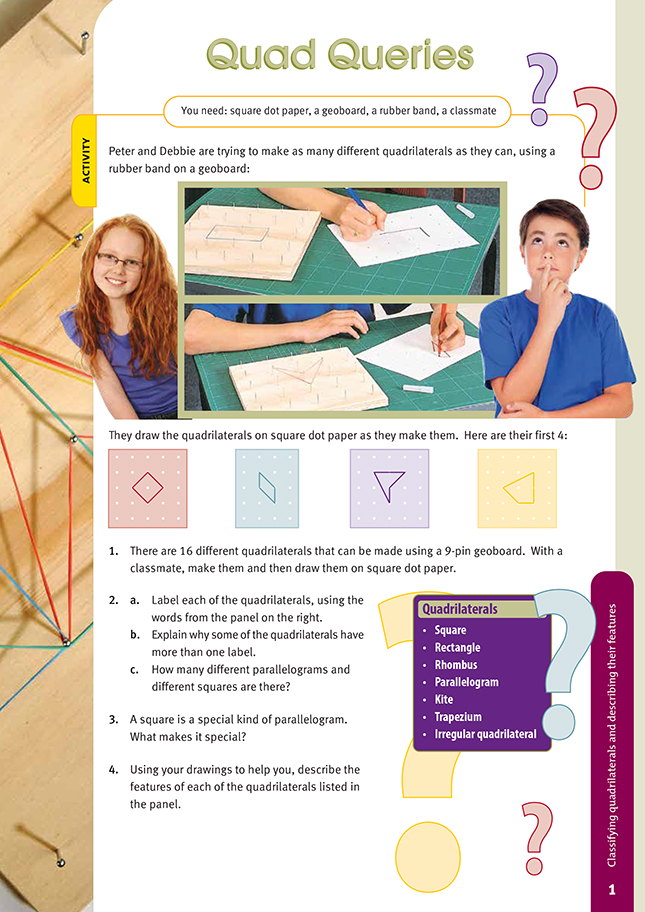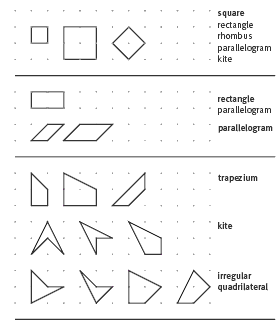This is a level 4 geometry strand activity from the Figure It Out series.
A PDF of the student activity is included.
Click on the image to enlarge it. Click again to close. Download PDF (261 KB)
classify quadrilaterals
describe their features
FIO, Level 4, Geometry, Book One, Quad Queries, page1
square dot paper
geoboard and rubber band
classmate
In this activity, students create quadrilaterals, classify them, and then define the features of each kind in their own words. Those who have worked with quadrilaterals before will find that the activity revises and consolidates their knowledge. The fact that one kind of quadrilateral can be a special case of another will be a new concept for most students.
The students should be able to do question 1 with a minimum of instruction. All they need to know is that they are making 4-sided shapes within a 9-pin matrix. You may, however, need to clarify what is meant by 16 different quadrilaterals. Use a diagram like this and ask your students, "Are these rhombuses different?"
In this activity, it is only the shape that interests us, so the three rhombuses are the same. Your students may find it helpful to imagine each quadrilateral they make as the outline of a cardboard shape. Any other outline that they could draw by repositioning the cut-out or flipping it over counts as the same.
Questions 2 and 4 are deliberately circular. Question 2 creates the need for the definitions in question 4, and the definitions in question 4 are developed as a result of working through question 2. You could therefore leave whole-class discussion of question 2 until the students have completed their definitions in question 4. The Answers suggest definitions that are acceptable from students working at level 4 of the curriculum.
The following Venn diagram may help explain the way in which the various quadrilaterals are related. From it, we can make statements such as: "some parallelograms are rectangles", "all rectangles are parallelograms"
and "a square combines the properties of a rectangle and a rhombus".
Polygons are closed figures (that is, the sides join to enclose a space) bounded by straight lines. Quadrilaterals are polygons with 4 sides. Although the square is the only regular quadrilateral, many quadrilaterals are classified according to features that distinguish them from the rest, and the term "irregular" is normally reserved for those that don't fit any other category. Note that, although the activity does not use the word "arrowhead" for a concave kite, you can do so if you wish. A concave quadrilateral is one that has an (internal) angle greater than 180 degrees. Note also that the term "isosceles trapezium" is sometimes used to describe
trapeziums with an axis of symmetry.
You may like to discuss the concepts of necessary and sufficient conditions with your class. For example, for a quadrilateral to be square, it is necessary for it to have 4 right angles (or 4 equal angles), but this is not enough (sufficient) to make it a square (because a rectangle also meets this condition). To be a square, it must also have equal sides. Strictly speaking, for a quadrilateral to be a square, it needs equal sides and just one right angle. Have fun discussing this with your class!
You could also discuss the way in which the diagonals of each kind of quadrilateral intersect. Here are questions for your students to consider:
- Do the diagonals meet at right angles?
- Do they bisect each other (divide each other exactly in 2)?
- Is either of the diagonals an axis of symmetry?
- Does the arrowhead have 2 diagonals? (Yes, but they intersect outside the shape.)
As further activities, the students could find:
- the total number of squares (not different squares) that can be made on a 16-pin geoboard or even a 25-pin geoboard
- all the different quadrilaterals that can be made using a 16-pin geoboard
- how many degrees the (interior) angles of a quadrilateral add up to and a method of demonstrating this without a protractor.
Answers to Activity
1 -2.a. The 16 different quadrilaterals and their labels are:
2. b. Some quadrilaterals have more than one label because they are subsets of other quadrilaterals. For example, a rectangle is also a parallelogram (because it has 2 pairs of equal, parallel sides). A square is a subset of 4 other quadrilaterals.
c. There are 6 different parallelograms and 3 different squares. (The 3 squares are also parallelograms.)
3. All its sides are the same length, and all its angles are equal. That makes it the only truly regular quadrilateral.
4. Descriptions will vary but should include the following information:
- square: a quadrilateral with all sides equal and all angles 90o.
- rectangle: a quadrilateral with 2 pairs of equal, parallel sides and all angles 90o.
- parallelogram: a quadrilateral with 2 pairs of equal, parallel sides
- rhombus: a quadrilateral with all sides equal
- kite: a quadrilateral with 2 pairs of equal, adjacent sides
- trapezium: a quadrilateral with (only) 1 pair of parallel sides
- irregular quadrilateral: a quadrilateral that does not fit any of the above definitions


